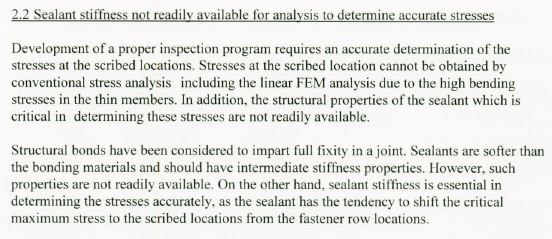Wil,
Thanks very much for the response, your words of caution are well taken. I always appreciate your depth of knowledge, I've learned a lot from your posts and this is no exception. For the record, just to note my statement was not entirely baseless on my part, I was thinking of a few papers which I will note below. Obviously I'm not trying to reduce any of your input above - I think if anything this discussion just does a good job highlighting the fact that this is not necessarily a simple issue at all.
In my experience with post-production support for 737 classics, one thing we run into a lot (obviously) is the scribe issue. So in the past I have endeavored to become as knowledgeable as possible on the issue. I recall several publications highlighting research and testing being done regarding the stiffness of the sealant. The main argument was that although not as effective as a structural bond, there was some shear capability which could lead to a change in the peak stress location. The concern was that if a scribe was made while removing sealant, maybe some disassembly of the lap and repair work was done, and then the structure was re-sealed, you would not only have a scribe, but due to the sealant stiffness, the peak stress location may actually be located closer to the scribe line, away from the outer fastener row. Below is an excerpt from the 2007 meeting of the international committee on aeronautical fatigue (ICAF) which discusses this a bit more:

Some discussion in [I am not, nor have I ever been employed by Boeing]:
Boeing SDT Document, "Development of a Method for Damage Tolerance Analysis for Scribe Marks Adjacent to Fuselage Longitudinal and Circumferential Splices"
de Rijck, "Stress Analysis of Fatigue Cracks in Mechanically Fastened Joints"
I think this may have also been discussed in the 2004 737 classic conference on scribes
This is why I mentioned theoretically, if you had a well adhered sealant, you could theoretically shift the peak stress away from the row of holes by some amount. However, I did not, nor would I, recommend attempting to take advantage of this in an analysis.
Also potentially interesting, although dealing with structural bonding, which is different, are some other resources:
DOT/FAA/CT-95/25, "Strain Fields in Boeing 737 Fuselage Lap Splices: Field and Laboratory Measurements with Analytical Correlations", in which bonded and non-bonded joints are compared
DOT/FAA/AR-98/33, Uniaxial and Biaxial Tests on Riveted Fuselage Lap Joint Specimens - simlar
Keep em' Flying
//Fight Corrosion!

![[thumbsup2] [thumbsup2] [thumbsup2]](/data/assets/smilies/thumbsup2.gif) is typical for protruding-head, 100-Deg flush-shear-head [NAS1097] and shallow 100-Deg flush-tension-head [MS20426] style rivets and Hi-Loks; BUT NOT for 100-Deg flush-deep/wide-tension-head bolts/screws (recess-drive) intended for occasional removal/re-installation [MS24694, NAS517, etc]... where 3D really is usually more appropriate.
is typical for protruding-head, 100-Deg flush-shear-head [NAS1097] and shallow 100-Deg flush-tension-head [MS20426] style rivets and Hi-Loks; BUT NOT for 100-Deg flush-deep/wide-tension-head bolts/screws (recess-drive) intended for occasional removal/re-installation [MS24694, NAS517, etc]... where 3D really is usually more appropriate.